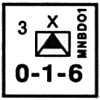By the middle of 1940 there were in theory two brigades forming a division of Royal Marines.
I said in theory, because the first rule of an Europa researcher examining British OB's is to ignore the title of units and instead dig up their real composition. For example, in early 1940 the 101st Brigade had only two battalions with a brigade strength half that of an army brigade; the division had an artillery "strength" of SIX 94mm Howitzers!
In practice, during this period the Marines consisted of a collection of battalions, six forming in the first months of 1940, and another four in early 1941. They were organised, on a rather random basis, into three unsupported brigades. The division never really exists in Europa terms.
The brigades did, being used in the abortive attack against the French at Dakar in August 1940 as well as acting for a time as a garrison in Iceland. Since I dislike the use, unless it is essential, of battalion counters in Europa these units are shown as brigades forming at the three great naval bases of Portsmouth, Plymouth and Chatham. Weak initially (although after Dunkirk at least as well equipped as most Army units), they upgrade in 1941 to reflect the creation of the new battalions.
A trickier question than the combat values of these units is their type. At the time of their formation they lacked training in, and had minimal equipment for amphibious landings. The light infantry symbol would be more appropriate. However, with the notable exception of the US Marines, the Marines of all major combatants - France, Russia, Germany and Italy lacked this expertise in 1940.
To be consistent they have therefore been given the classification and capabilities of Marines. But bear in mind that they are certainly not commandos at this time.
At the same time the Admiralty realised the need to establish 'temporary' Fleet Bases. The experience in Norway had demonstrated that fleet anchorages had to be well defended against air, ground and naval attack.
 They therefore ordered the
establishment of a Mobile Naval Base
Defense Organisation - the strange
MNBDO counter found in Balkan Front.
It has significant effects in a naval
game - being comparable to the bases
established in the Pacific by the US
from 1942 on. As with its US
counterparts it contained an integral
Marine coast-artillery unit, with eight 6"
and four 4" guns.
They therefore ordered the
establishment of a Mobile Naval Base
Defense Organisation - the strange
MNBDO counter found in Balkan Front.
It has significant effects in a naval
game - being comparable to the bases
established in the Pacific by the US
from 1942 on. As with its US
counterparts it contained an integral
Marine coast-artillery unit, with eight 6"
and four 4" guns.
As far as the ground war is concerned it had an integral Marine battalion, and the equivalent of a reduced AA brigade - 2 heavy and 1 light regiments. Incidentally, only about 50% of the assets were at Crete at the time of the German attack, hence the reduced rating in Balkan Front.
After Crete, the MNBDO was reorganised in Egypt, operated at Haifa and Alexandria, and in mid-1943 left for Ceylon to boost the facilities of the Eastern Fleet. By this time a second MNBDO had been organised in the United Kingdom and was sent to the Middle East. On the capture of the Italian ports it was no longer required, returned to the UK, and its AA assets used to form the 5th AA Brigade.
The Royal Marines Missing Europa Units:
Back to Europa Number 15 Table of Contents
Back to Europa List of Issues
Back to MagWeb Master Magazine List
© Copyright 1990 by GR/D
This article appears in MagWeb (Magazine Web) on the Internet World Wide Web. Other military history articles and gaming articles are available at http://www.magweb.com